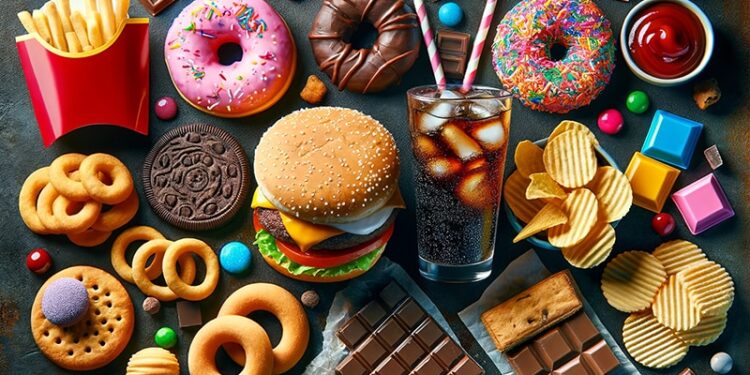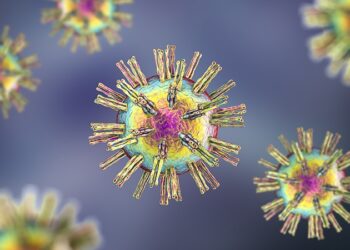Ultraprocessed foods (UPFs) are the staples of modern diets; however, their health effects remain a topic of debate. At the 131st Congress of the German Society for Internal Medicine, experts called for a more nuanced perspective. The discussion was led by Professor Martin Smollich, PhD, head of the Pharmaconutrition Working Group at the Institute for Nutritional Medicine, University Hospital Schleswig-Holstein, Lübeck, and Anja Bosy-Westphal, MD, PhD, professor of Human Nutrition at Christian-Albrechts-University of Kiel, Kiel, both in Germany.
Expert Perspective
Opening his presentation, Smollich clarified, “I am not going to recommend that you and your patients consume as many UPFs as possible, but I advocate for differentiation in this area. In both professional and lay press, UPFs are often associated with increased mortality and other diseases. This led to the hypothesis that UPFs are harmful to health because of their level of processing, regardless of their nutritional profiles.”
According to Smollich, this represents a novel concept: “Traditionally, nutritional science considers how foods function based on their contents — not on the processing itself.”
NOVA Classification
Recently, the NOVA classification, a four-level evaluation, introduced by Carlos A. Monteiro, a PhD epidemiologist and professor of nutrition and public health at the University of Sao Paulo, Sao Paulo, Brazil, has gained global recognition for categorizing UPFs based on their degree of processing.
- NOVA 1: Unprocessed/minimally processed foods, such as raw foods, eggs, meat, milk, nuts, coffee, and tea
- NOVA 2: Processed culinary ingredients, such as flour, sugar, honey, salt, butter, and vegetable oils
- NOVA 3: Processed foods, such as bread, cheese, and canned vegetables
- NOVA 4: UPFs, which are industrially processed and “convenient” and contain additives
Smollich described the definition behind the NOVA classification as subjective.
According to the NOVA classification, UPFs are characterized by industrial processing, convenience of preparation, and the presence of additives.
“However, it is not reasonable to claim that all NOVA-4 foods are inherently bad.” Beyond the expected products, such as chips, chocolate bars, fries, and cola, organic sauerkraut, ready-to-eat green kidney beans, and brown bread fall into NOVA 4.
“Why is brown bread classified as an UPF? This is because it contains iodized salt. This counts as an additive; it is not natural — thus, it falls into NOVA 4,” Smollich explained.
“Consider sauerkraut with the additive E300, behind which ascorbic acid acts as an antioxidant. However, this is added as an additive and, therefore, NOVA 4,” he cited another example.
Thus, although the concept may appear intuitively convincing, it does not apply to all foods.
Common Myths
1. UPFs Are Super Tasty
Foods are often perceived as delicious when they contain high amounts of fat and sodium, such as chips; fat and sugar, such as Nutella; or sugar and sodium.
These combinations are typical of UPFs and are therefore considered “hyper-tasty.” However, Smollich argued that these aspects are unrelated to processing, as they are related to product ingredients.
“We also have non–NOVA-4 foods that exhibit these hyper-tasty nutrient ratios, such as cheese and salted nuts. UPFs possess a distinctive texture, and many are designed for the palate, such as chips and Nutella. However, this distinctive texture also applies to foods from NOVA classes 1-3, including fruit juices, syrups, and honey. We cannot say this is exclusive to UPFs, as there are marked differences among UPFs such as tofu and cola,” he said.
2. UPFs Have a Very High Energy Density
Smollich contends that very high energy density is not a unique feature of UPFs. Some NOVA-4 foods that do not have high energy densities include tofu, vegetable stews, and ready-to-eat beans. Conversely, foods with high energy densities, such as butter, nuts, oils, honey, oatmeal, and dried fruits, are classified as NOVA class 1 or 2.
3. UPFs Contain Many Additives
According to Smollich, the negative blanket assessments of 320 approved additives lack adequate supporting evidence. Additives vary widely in their chemical and physiological properties, and this concept fails to account for dose dependency. It is also misleading to claim that colorings are not beneficial, citing the differences between berry anthocyanins and allergenic azo dyes. He added that many additives, such as ascorbic acid, chlorophyll, and citric acid, are naturally occurring.
“It is important to differentiate within the group of UPFs,” Smollich said.
Disease Burden
“Numerous correlation studies have shown that increased UPF consumption is associated with a higher disease burden. However, several large cohort studies have differentiated between food groups. Consequently, there is no blanket association between UPF consumption and noncommunicable diseases.” he said.
For instance, a Dutch Lifelines cohort study demonstrated that higher UPF consumption was correlated with increased overall mortality. However, further analyses clarified that when differentiated by the food group, the association remained only for soft drinks and ultraprocessed meat products. For all other UPF products, the results were either neutral or, as with whole-grain UPFs or cereals, associated with lower mortality rates.
Results from the UK Biobank cohort suggest a similar conclusion: “What we perceive as the UPF effect is probably a soft drink effect that is statistically dominant, overshadowing other factors.”
Ban Debate
“This may seem plausible at first, but I would not concur,” said Smollich.
Current dietary guidelines, such as the German Nutrition Society and Nordic Nutrition Recommendations, do not recommend a blanket ban on UPF consumption. Consistent adherence to this would lead to serious disadvantages, such as the nutritional intake in the Western world coming from UPFs to the tune of 50%-91%. One must ask, “Where would that intake come from instead?”
Additionally, a blanket ban on UPFs would signal to patients that non-UPFs are inherently healthy. However, foods such as sugar, honey, salt, fruit juice, syrup, and salted nuts are not necessarily healthy because they are not ultraprocessed. A blanket ban would also overlook conflicts of interest and lead to negative assessments of items such as iodized salt and plant-based drinks. All food groups, such as gluten- and lactose-free foods and infant nutrition, are affected by the blanket ban on UPFs.
Ecological aspects, including resource efficiency, must also be considered, as a blanket ban could lead to increased food waste. Another concern is socioeconomic reality; for example, “If we say: Only fresh, no UPFs anymore, the question arises: Who is supposed to do that? — particularly in a world where 70% of the global population will reside in cities by 2050. From my perspective, it is unrealistic to expect people to live without consuming UPFs,” Smollich warned.
On the one hand, there are UPFs with poor nutritional profiles, such as soft drinks, ultraprocessed meats, sweets, and chips. In contrast, foods with good nutritional profiles include infant formulas, gluten-free foods, plant-based drinks, whole-grain bread, tofu, vegetable spreads, yogurt, high-quality frozen meals, and sauerkraut.
Pros and Cons
Health assessment of foods based solely on processing levels lacks evidence. Differentiation is crucial for UPFs. A notable association exists between UPF consumption and morbidity, particularly in the case of soft drinks and highly processed meat.
Samuel J. Dicken and colleagues revealed that UPFs have poorer nutritional profiles than minimally processed and processed products and contain more sugar and higher energy density. “Even if it is not characteristic of all UPF products, on average, we can assert that they do,” Bosy-Westphal began her argument.
A total of 17 prospective cohort studies found a relationship between UPF intake and obesity. Notably, 93% of these relationships remained unchanged after adjusting for nutrients, dietary patterns, and other NOVA groups.
“It cannot depend solely on the nutritional profile,” she said.
Speed of Consumption
A randomized crossover study by Kevin D. Hall, MD, from the National Institute of Diabetes and Digestive and Kidney Diseases, Bethesda, Maryland, and colleagues assigned two groups of participants to either a UPF diet or a “minimally processed food” diet for 14 days. Both diets had equivalent caloric, sugar, fat, fiber, and macronutrient profiles.
The results revealed that the UPF group consumed approximately 500 kcal/d of more energy. Thus, the effect was independent of the nutritional profile. “Ultimately, it was all due to eating speed, which is an important parameter. Anything you can eat quickly is not particularly good for our satiety.”
Another randomized crossover study from Japan indicated that participants in the UPF group experienced higher energy intake and weight gain despite a lower chewing frequency.
In addition to changes in energy density, the texture of the food also changed.
The “soft food matrix” allows for faster calorie absorption. A study focusing on food texture demonstrated that “soft-textured” foods led to participants eating more; initially, this was independent of whether the soft-textured foods were UPFs.
Nutritional Quality
In another study, over 8600 processed and UPFs were compared in terms of their nutritional quality. Foods in the UPF category generally contained less protein, less fiber, and more sugar. Additionally, they contain fewer micronutrients, such as calcium, vitamins B1 and B2, and zinc.
“With UPFs, we frequently deal with poor-quality carbohydrates. An inverse dose-dependent relationship exists between UPF consumption and dietary fiber intake. In fact, fibers are typically found only in foods that do not fall into the UPF category,” Bosy-Westphal summarized.
Hyperpalatability Effect
“You are not actually hungry, yet you keep eating” — this phenomenon is referred to as hyperpalatability. When you are on a Mediterranean diet, you cannot overconsume vegetables. You have to chew them for so long; you cannot take calories quickly. However, this can be achieved using UPFs. Dicken and colleagues examined various foods for palatability and revealed that 47% of the examined foods were rated as highly palatable based on their fat, salt, sugar, and carbohydrate contents, and 80% of these were UPFs.
“Of course, this is not exclusive, and exceptions exist. I do not support a simplistic classification based on Monteiro, but evidence shows how food processing contributes to overconsumption,” explained Bosy-Westphal.
Is a Plant-Based Diet With a High UPF Content Unhealthy?
“One might assume that as long as the foods are plant-based, ultraprocessing is not a problem at all,” she said.
However, an increasing number of studies have demonstrated that the consumption of so-called “unhealthy plant foods” raises the risk for cardiovascular diseases, both compared with the consumption of fresh plant foods and processed animal products.
Substitution Debate
“Meat substitutes: To demonize or not to demonize?”
This question was also addressed during the plenary session, which followed the presentations. Smollich commented, “Definitely not demonizing. I believe that you must consider individual products. When patients ask me whether food is good or bad, I always respond, ‘Compared to what?’ Replacing a meat burger with a plant-based burger every day is different from choosing a plant-based burger over a fresh salad. From a nutritional standpoint, I would recommend that, if possible, go for minimally processed foods and plenty of fresh vegetables. But if you are comparing junk food with junk food, I would often rate the plant-based option more favorably.”
Bosy-Westphal added, “If we want to shift toward more plant-based diets as part of transforming our food systems, then alternatives can play an important role. Why must it be meat sausage? Plant-based options can also work just as well. Both, however, fall under the category of UPF foods.”
Conclusion
High energy density, intense flavor, and soft texture are not exclusive characteristics of UPF; “we can also produce food at home that meets these criteria. However, today, the industry cooks for us: We consume a high proportion of industrially processed foods, and half of our energy needs are covered by UPFs.” UPFs are on the one hand inexpensive, are long-lasting, and require little effort for consumption. However, on the other hand, they are very energy-dense; contain sweeteners and flavorings; while also providing fewer nutrients, fibers, and omega-3 fatty acids. “We must continue to work on these problems,” Bosy-Westphal concluded.
This story was translated from Coliquio.
Source link : https://www.medscape.com/viewarticle/do-ultraprocessedfoods-deserve-bad-reputation-2025a1000db9?src=rss
Author :
Publish date : 2025-05-27 12:34:00
Copyright for syndicated content belongs to the linked Source.














